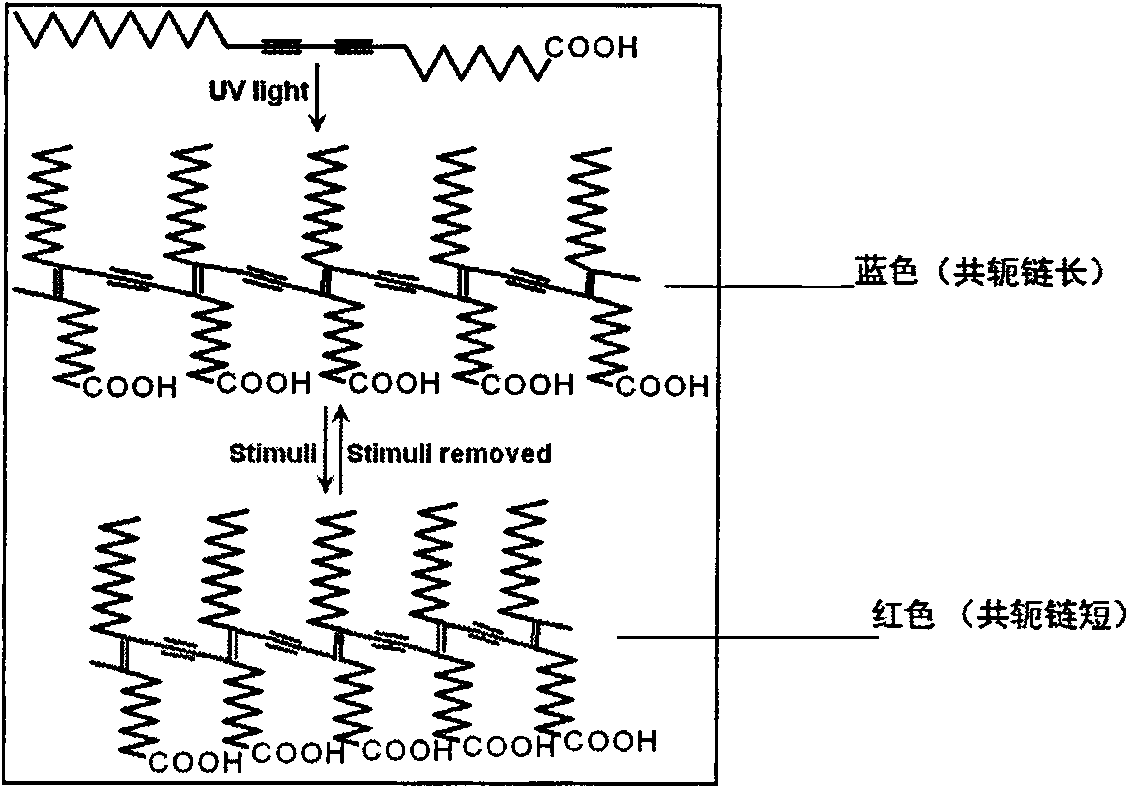Reversible electrochromism composite fiber and preparation method thereof
A composite fiber and carbon nanotube fiber technology, which is applied in the fields of carbon fiber, fiber treatment, textiles and papermaking, etc., can solve the problems such as the difficulty of conformational transformation of polydiyne, and achieve the effect of wide application potential and simple preparation method
- Summary
- Abstract
- Description
- Claims
- Application Information
AI Technical Summary
Problems solved by technology
Method used
Image
Examples
specific example 1
[0037] Monomer CH 3 (CH 2 ) 11 C≡C-C≡C(CH 2 ) 8 COOH was dissolved in tetrahydrofuran to prepare a 10 mg / ml diyne monomer solution. Then the carbon nanotube fibers with a diameter of 11 μm were immersed in the diacetylenic monomer solution for 10 minutes, and the solvent was evaporated at room temperature after taking it out. Place in fume hood for 24 hours. Irradiate with a UV lamp with a wavelength of 254nm at a distance of 17cm from the fiber for 1 hour to polymerize the diacetylene monomer on the fiber to obtain a blue carbon nanotube / polydiyne composite fiber. Take a piece of fiber and fix it on the glass substrate, and connect the two ends with silver glue and gold wire. The gold wire is connected with the current source, and the current is passed through. Continuously increasing the current value, when the current is less than 10mA, the composite fiber has no obvious change. When the current is greater than 10mA but less than 30mA, the composite fiber turns red ...
specific example 2
[0039] The monomer HOOC(CH 2 ) 8 C≡C-C≡C(CH 2 ) 8 COOH was dissolved in tetrahydrofuran to prepare a 10 mg / ml diyne monomer solution. Then the carbon nanotube fibers with a diameter of 11 μm were immersed in the diacetylenic monomer solution for 30 minutes, and the solvent was evaporated at room temperature after taking it out. Place in fume hood for 24 hours. Irradiate with an ultraviolet lamp with a wavelength of 254nm at a distance of 17 cm from the fiber for 1.5 hours to polymerize the diacetylenic monomer on the fiber, and also obtain blue carbon nanotube / polydiyne composite fiber. Take a piece of fiber and fix it on the glass substrate, and connect the two ends with silver glue and gold wire. The gold wire is connected with the current source, and the current is passed through. Continuously increasing the current value, when the current is less than 10mA, the composite fiber has no obvious change. When the current is greater than 10mA but less than 30mA, the compo...
specific example 3
[0041] Monomer HOCH 2 C≡C-C≡CCH 2 OH was dissolved in tetrahydrofuran to prepare a 10mg / ml diyne monomer solution. Then the carbon nanotube fibers with a diameter of 11 μm were immersed in the diacetylenic monomer solution for 20 minutes, and the solvent was evaporated at room temperature after taking it out. Place in fume hood for 24 hours. Irradiate with an ultraviolet lamp with a wavelength of 254nm at a distance of 17 cm from the fiber for 2 hours to polymerize the diyne monomer on the fiber to obtain an orange carbon nanotube / polydiyne composite fiber. Take a piece of fiber and fix it on the glass substrate, and connect the two ends with silver glue and gold wire. The gold wire is connected with the current source, and the current is passed through. Continuously increasing the current value, when the current is less than 10mA, the composite fiber has no obvious change. When the current is greater than 10mA and less than 30mA, the composite fiber turns brown within 2 ...
PUM
| Property | Measurement | Unit |
|---|---|---|
| Diameter | aaaaa | aaaaa |
| Length | aaaaa | aaaaa |
| Diameter | aaaaa | aaaaa |
Abstract
Description
Claims
Application Information
 Login to View More
Login to View More - R&D
- Intellectual Property
- Life Sciences
- Materials
- Tech Scout
- Unparalleled Data Quality
- Higher Quality Content
- 60% Fewer Hallucinations
Browse by: Latest US Patents, China's latest patents, Technical Efficacy Thesaurus, Application Domain, Technology Topic, Popular Technical Reports.
© 2025 PatSnap. All rights reserved.Legal|Privacy policy|Modern Slavery Act Transparency Statement|Sitemap|About US| Contact US: help@patsnap.com



